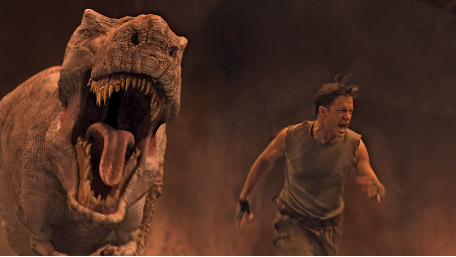BY DANIEL FRANKEL

 BEFORE AND AFTER: A previs frame and the actual shot from Journey to the
BEFORE AND AFTER: A previs frame and the actual shot from Journey to the
Center of the Earth. Director Eric Brevig says previs helped actors interact with
digital elements, such as this giant T-Rex. (Credit: Walden Media)
You might expect the previsualization process, or previs as it is more commonly known, to help with the giant alien spaceship for the recent Star Trek movie, which it did. But the follow-up to Todd Phillips’ R-rated summer comedy hit The Hangover seems like a strange project for previs artists to be contributing to. Nonetheless, David Dozoretz and his previs shop, Persistence of Vision, are working on several scenes for the upcoming film, Due Date, which is not the kind of action-oriented, visual effects-driven movie typically associated with computer-based previsualization software.
“It isn’t an effects movie, and it was just two small sequences, but because the timing was so tough, Phillips said, ‘You know what, we’ll just previs it,’” explains Dozoretz, whose company also worked on Star Trek.
According to Phillips, the technology wasn’t used extensively. “It’s not like we were making Transformers,” he quips, adding that it was quite useful in terms of coordinating several stunt-heavy scenes involving moving cars. “We use previs very simply to pull our teams together and let the stunt guys know what we’re talking about,” Phillips says. “It was a way for us to communicate to all the different departments what we were doing and it kind of fills in the holes that storyboards don’t. The software is accessible now, and it’s a good, simple tool to have.”
While Francis Ford Coppola experimented with the early use of electronic imagery in One from the Heart in 1982, Dozoretz was one of the first to use previs for an entire sequence for Mission: Impossible (1996), which led to George Lucas hiring him for the Star Wars prequels, marking the first time a previs artist worked directly with the filmmaker rather than the visual effects supervisor.
Today, with improvements in the software, previs allows filmmakers to create quick, detailed, computer-animated versions of scenes before expense and time are committed to actually shooting them. What’s attractive for directors is the ability to experiment in advance with elements such as staging, lighting, art direction and camera movement.
And the technology, which was previously confined to large-scale projects involving copious digital elements, is beginning to migrate into lower budget film production. Chris Edwards, who runs the Los Angeles-based previs shop, The Third Floor, which worked on James Cameron’s upcoming extravaganza, Avatar, says previs software tools and the artists who use them are now being embraced by other budgetary levels of the film business besides effects-driven studio tentpoles. For instance, director Eric Brevig used previs extensively on 2008’s Journey to the Center of the Earth, which was made on a $40 million budget.
“It is useful for things besides visual effects sequences,” Brevig explains. “It’s really helpful for any kind of action sequence, where the dynamics of what you’re filming involve a lot of detailed planning. Previs gives us a good representation of what’s going on at an inexpensive price and brings your entire filmmaking team in on your plans in a way that’s very clear and very understandable.”
In addition, Brevig says previs was particularly effective in helping his actors better understand how to interact with digital elements, such as a giant T-Rex, that weren’t actually on the set. “By bringing the actors into the audience for a moment, and having them watch an animated rendering of the scene, it gives them a better understanding of how things are going to play out.”
That said, the technology still isn’t cheap. Edwards estimates directors of high-end projects that include heavy use of digital elements might spend up to $2 million if they’re prevising every scene from scratch.
For films like Iron Man 2, which are loaded with visual effects and various other digital elements, director Jon Favreau says the investment is worthwhile. The technology is currently letting him charge ahead in postproduction, even though the visual effects shops employed are still working on digital characters and scenes. These can be plugged in later, overlaying the previs renderings. “It allows you to cut the movie as if everything is practically in the can,” says Favreau, “and it helps you envision what the frame will ultimately look like. You’re not just cutting together plates.”
On the lower end of the price spectrum, Edwards says that directors like Phillips can spend as little as $5,000 to create a computer model of a complex action scene that might otherwise lead to hundreds of thousands—or even millions—of dollars wasted if the camera angles aren’t correct, or if the lighting is off.
Indeed, supporters of previs suggest that not to use the technology can be penny-wise and dollar foolish. Mat Beck, a visual effects supervisor on films including Miami Vice and Spider-Man 2 (and a DGA member) says the technology’s greatest benefit is that it actually enhances the director’s creativity, enabling various experiments to be tried out in the computer “before marching the entire army across the battlefield. You only commit big resources once you’ve honed your vision to something that’s cost-effective and doable.”
Edwards and other previs proponents believe the technology has only scratched the surface in terms of what it can do for the average filmmaker. He sees a filmmaking model of the future in which the previs supervisor serves as the “nexus” for all personnel on the movie set, from storyboard artists to editors to camera operators to production designers, “combining everyone’s input into a cohesive vision that can be critiqued and refined until it represents the director’s vision.”
In such a paradigm, tasks like editing could occur in preproduction rather than in postproduction. In fact, Dozoretz notes that high-end directors, including James Cameron, are using the technology as the “two-by-four structure” of their film from the very beginning of production, creating an entire movie’s worth of previs, then adding finished scenes and elements to that file as they go along.
"At that point, it gets to be a very blurry line between what is previs and what is production," says Favreau. “It would be hard to say when preproduction really ends and production starts. These are things that are going to be open for definition by future generations."
While Favreau agrees that "previs is the future," and, like a number of other digital tools, will one day utterly transform the production workflow for all directors, he doesn’t see that happening any time soon. "The question is, when does previs become financially feasible for smaller productions?" he wonders. "In the short term, I think it is still a luxury, and it will remain so for the foreseeable future. I don’t think a lot of filmmakers see it as a line item they need to explore."
Nelson McCormick, director of the upcoming remake of the slasher film The Stepfather, agrees. “There really isn’t that much need for it in the kind of films I do,” he says. On the $20 million Stepfather, only two scenes required big stunts where a lot of departments had their hands involved. “Nothing we did required us to experiment ahead of time.”
For many productions, traditional storyboarding is still adequate for most scene planning, adds Brevig, who notes that the skill set is in no danger of obsolescence. “It’s always the first step and it remains the most inexpensive way for planning a scene,” he says. “If you have two people at a table just hashing out ideas, it doesn’t make a lot of sense to previs that.”
However, while previs may not yet be a practical production tool for all directors, Brevig does see the technology’s ability to communicate beyond the set. He says he regularly uses previs to convey his plans to producers and studios, showing them animated reels of particularly expensive scenes before actually shooting them. “They can see what they’re buying and make very informed choices,” he says.
At the same time, Edwards says his company is starting to get work from independent producers who are requesting the creation of “pitchvis” reels, which are short, animated “trailers” that they can present in their quest for funding.
“The technology is getting better all the time,” Beck maintains. “It’s a disruptive technology, but in a good sense. I believe that one day it will change the entire filmmaking process.”